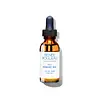What's inside
What's inside
 Key Ingredients
Key Ingredients

 Benefits
Benefits

 Concerns
Concerns

 Ingredients Side-by-side
Ingredients Side-by-side

Squalane
EmollientDicaprylyl Carbonate
EmollientCaprylic/Capric Triglyceride
MaskingLimnanthes Alba Seed Oil
Skin ConditioningPrunus Amygdalus Dulcis Oil
Skin ConditioningRosa Canina Fruit Oil
EmollientTocopheryl Acetate
AntioxidantTocopherol
AntioxidantHippophae Rhamnoides Seed Oil
Skin ProtectingRubus Idaeus Seed Oil
EmollientSimmondsia Chinensis Seed Oil
EmollientZingiber Officinale Root Extract
MaskingHelianthus Annuus Seed Oil
EmollientAvena Sativa Kernel Oil
Skin ConditioningBacillus Ferment
Skin ConditioningRosmarinus Officinalis Leaf Extract
AntimicrobialSqualane, Dicaprylyl Carbonate, Caprylic/Capric Triglyceride, Limnanthes Alba Seed Oil, Prunus Amygdalus Dulcis Oil, Rosa Canina Fruit Oil, Tocopheryl Acetate, Tocopherol, Hippophae Rhamnoides Seed Oil, Rubus Idaeus Seed Oil, Simmondsia Chinensis Seed Oil, Zingiber Officinale Root Extract, Helianthus Annuus Seed Oil, Avena Sativa Kernel Oil, Bacillus Ferment, Rosmarinus Officinalis Leaf Extract
Prunus Amygdalus Dulcis Oil
Skin ConditioningHelianthus Annuus Seed Oil
EmollientIsoamyl Laurate
EmollientCarthamus Tinctorius Seed Oil
MaskingOenothera Biennis Oil
EmollientPassiflora Edulis Seed Oil
EmollientCitrus Paradisi Peel Oil
MaskingTetrahexyldecyl Ascorbate
AntioxidantNigella Sativa Seed Oil
EmollientRubus Occidentalis Seed Oil
EmollientVaccinium Macrocarpon Seed Oil
Skin ConditioningPunica Granatum Seed Oil
EmollientDimethylmethoxy Chromanol
AntioxidantRosa Canina Fruit Oil
EmollientTocopherol
AntioxidantGuaiazulene
AntimicrobialTocopheryl Acetate
AntioxidantPrunus Amygdalus Dulcis Oil, Helianthus Annuus Seed Oil, Isoamyl Laurate, Carthamus Tinctorius Seed Oil, Oenothera Biennis Oil, Passiflora Edulis Seed Oil, Citrus Paradisi Peel Oil, Tetrahexyldecyl Ascorbate, Nigella Sativa Seed Oil, Rubus Occidentalis Seed Oil, Vaccinium Macrocarpon Seed Oil, Punica Granatum Seed Oil, Dimethylmethoxy Chromanol, Rosa Canina Fruit Oil, Tocopherol, Guaiazulene, Tocopheryl Acetate
Ingredients Explained
These ingredients are found in both products.
Ingredients higher up in an ingredient list are typically present in a larger amount.
Helianthus Annuus Seed Oil is the oil derived from the seeds of a Sunflower. Sunflower seed oil is non-fragrant. It is an emollient, meaning it helps to soften the skin.
Sunflower seed oil contains many fatty acids. The fatty acids found in sunflower seeds include (from highest amount to least): linoleic acid, myristic acid, palmitic acid, stearic acid, arachidic acid, oleic acid, and linolenic acid.
These fatty acids help the skin create ceramides. Ceramides play a role in repairing the skin barrier.
Helianthus Annuus Seed Oil helps moisturize the skin. This in turn helps the skin look more rejuvenated and smoother.
Sunflowers are rich in vitamin E.
Historians believe Indigenous cultures of North America domesticated sunflowers before corn. Thus they relied on sunflower oil for a variety of uses. One such use is moisturizing skin and hair.
Sunflower seed oil may not be fungal acne safe. We recommend speaking with a professional if you have any concerns.
Learn more about Helianthus Annuus Seed OilPrunus Amygdalus Dulcis Oil comes from the sweet almond, a tree native to Iran. This oil has no fragrance and is non-volatile.
Almonds contain healthy fats, vitamins, and minerals. It is a rich source of Vitamin E, a great antioxidant and skin conditioning ingredient. Sweet almond oil contains fatty acids such as linolenic acid and triglycerides.
The content of sweet almond oil makes it a great emollient; it can help soften and hydrate your skin. Emollients create a barrier over your skin to trap moisture in. Sweet almond oil has antioxidant properties.
Those with an almond allergy should be careful of this ingredient and speak with a professional about using it in your skincare.
This ingredient may not be fungal-acne safe.
Learn more about Prunus Amygdalus Dulcis OilRosehip Oil is a non-fragrant plant oil. Rosehips are a fruit from a rose bush and are edible. This oil has skin conditioning and hydrating properties.
Rosehip contains Vitamin C, Vitamin E, fatty acids and linolenic acids. These nourish your skin barrier. Having hydrated skin may help reduce the appearance of fine-lines and wrinkles.
Another great component of Rosehip Oil is Vitamin A, or retinol. Vitamin A encourages your skin to create more collagen.
Rosehip oil may help with reducing pigmentation. The lycopene and beta-carotene have skin-lightening properties. However, more studies are needed to confirm this.
Learn more about Rosa Canina Fruit OilTocopherol (also known as Vitamin E) is a common antioxidant used to help protect the skin from free-radicals and strengthen the skin barrier. It's also fat soluble - this means our skin is great at absorbing it.
Vitamin E also helps keep your natural skin lipids healthy. Your lipid skin barrier naturally consists of lipids, ceramides, and fatty acids. Vitamin E offers extra protection for your skin’s lipid barrier, keeping your skin healthy and nourished.
Another benefit is a bit of UV protection. Vitamin E helps reduce the damage caused by UVB rays. (It should not replace your sunscreen). Combining it with Vitamin C can decrease sunburned cells and hyperpigmentation after UV exposure.
You might have noticed Vitamin E + C often paired together. This is because it is great at stabilizing Vitamin C. Using the two together helps increase the effectiveness of both ingredients.
There are often claims that Vitamin E can reduce/prevent scarring, but these claims haven't been confirmed by scientific research.
Learn more about TocopherolTocopheryl Acetate is AKA Vitamin E. It is an antioxidant and protects your skin from free radicals. Free radicals damage the skin by breaking down collagen.
One study found using Tocopheryl Acetate with Vitamin C decreased the number of sunburned cells.
Tocopheryl Acetate is commonly found in both skincare and dietary supplements.
Learn more about Tocopheryl Acetate